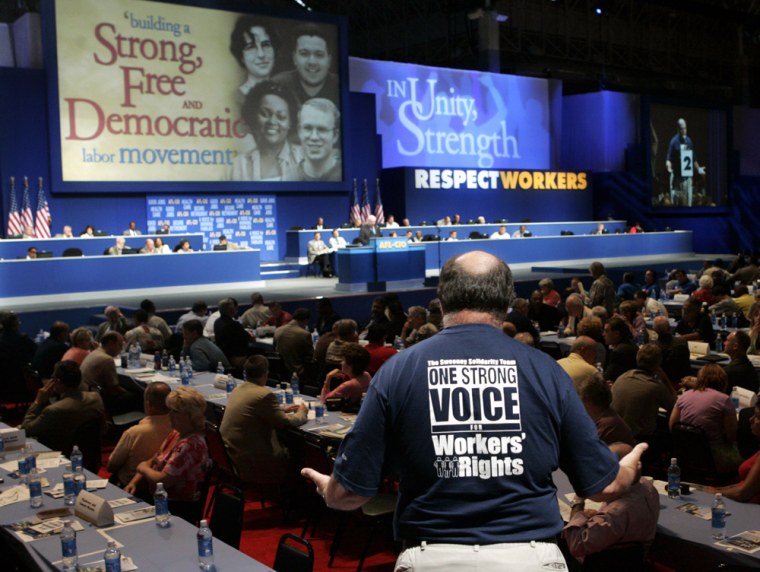Wren Bradley loves her union, but she said her “other heart” is committed to her local labor council — which she’ll be forced to leave because of a massive schism in the AFL-CIO.
Bradley is a member of the Service Employees International Union, which joined the Teamsters in defecting from the labor giant just as its 50th anniversary convention got under way last week in Chicago. The United Food and Commercial Workers announced its departure Friday.
On the convention’s last day, AFL-CIO President John Sweeney made it clear that members of those disaffiliated unions will no longer be allowed as regular participants in the 51 AFL-CIO-chartered state federations and nearly 550 central labor councils. That includes voting, serving as an officer or participating in decisions on political endorsements.
Those local bodies are where much of the grassroots work of the labor movement gets accomplished — through coordination of legislative, political and community service work. They support strikes, assist in organizing, publicize boycotts and work on common issues.
Despite assurances from top AFL-CIO leaders of the federation’s strength, some of the rank-and-file members fear what will happen to their local labor efforts in the wake of the breakup — and wish a compromise on the makeup of councils could have been reached.
“No one union can do it on their own. It requires the cooperation and a coalition with everyone,” said Bradley, a trustee of the Monterey Bay Central Labor Council in California. “We’re going to be devastated.”
But others say Sweeney’s decision was the right thing to do — that if the dissident unions are not going to participate or pay dues to the AFL-CIO on the national level, they can’t expect to have a voice on the local level. In fact, they say, the AFL-CIO’s bylaws required Sweeney to take a stand.
“We have a constitution, and we have a constitution for a good reason,” said Lee Schillinger, a high school teacher who serves as the president of the Northeastern Illinois Federation of Labor.
The Teamsters, SEIU and UFCW comprised more than 4 million of the AFL-CIO’s 13 million members and contributed almost $28 million to an estimated $120 million budget.
The dissident unions said Sweeney had done too little to reverse the decades-long decline in union membership and accused him of focusing more on building political clout than on efforts to recruit new members.
They also wanted Sweeney’s ouster after 10 years in the post. Instead, he was re-elected to a fourth term.
The three disaffiliated unions belonged to a seven-member coalition called Change to Win. One other member, Unite Here, is still considering whether to stay with the AFL-CIO.
How the defections will affect central labor councils — which are usually volunteer-run coalitions — will vary in each case.
Bradley, of Salinas, Calif., estimates 70 percent of her council is made up of the three disaffiliated unions and Unite Here.
Council members, all volunteers, have worked together to try to stop a Wal-Mart superstore from locating in the area, coordinated on issues concerning immigrant workers and keep in regular touch between their monthly meetings, she said.
On the Southern Maine Labor Council, about 20 percent of its 4,000 members belong to the Change to Win Coalition, said its president, Peter Kellman, a college history teacher from North Berwick, Maine.
In Illinois, Schillinger said the departure of UFCW would hit his council the hardest, because its locals contributed about 2,200 workers to his 20,000 member group. Two of his fellow council officers are also members of the UFCW, and their loss “would be a very emotional, difficult thing.”
Unions pay $2 per year per member to affiliate with his council, and Schillinger worries about having to raise those fees to make up for the members that will be pushed out by their unions’ defections.
Sweeney acknowledged that many of the members of the disaffiliated unions have excellent relationships with their local councils. And he said some of the state federations and central labor councils “are going to suffer considerably” in the wake of the defections.
He pledged that the AFL-CIO will assist them financially. He also asked each of the groups to do an analysis to show the impact of the defections, which will be used at a special September meeting of the executive council to decide where the needs are most acute.
As delegates from the convention headed home, several said they expect to continue some kind of partnership with members of the dissident unions, working on common challenges facing working families in their communities.
“I’ve known a lot of the people I work with for 30 years — we’ve been through strikes and lockouts and picket lines and all kinds of things,” said Kellman, wearing a “union steward” button on his baseball cap. “Those relationships, I think, will survive anything like this.”
